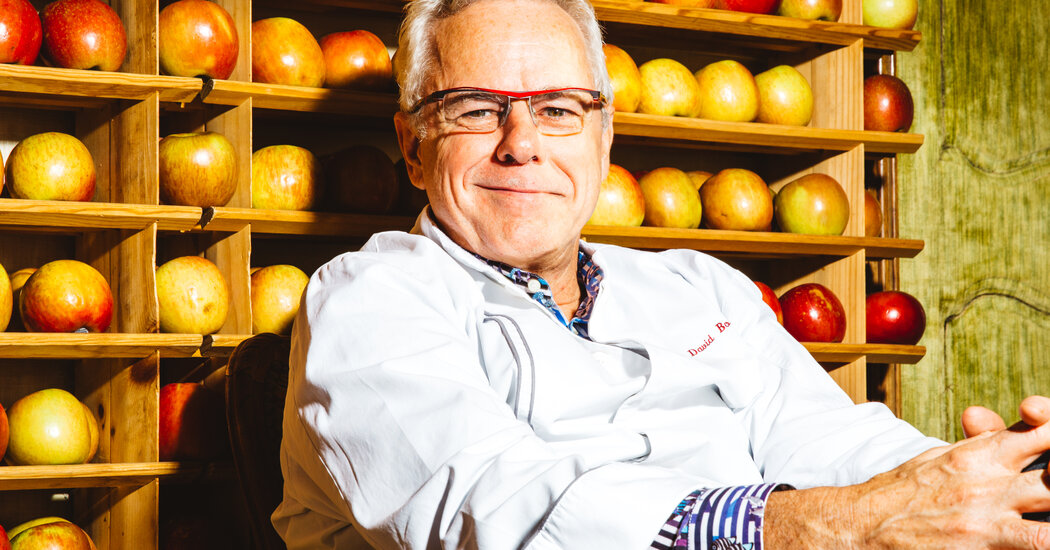Whenever I talked to David Bouley, the exacting, pioneering American chef who died on Monday at age 70, out would pour a torrent of ideas, beliefs, theories, nutritional research, probiotic preservation methods, ethnographic histories and plans for harnessing all this knowledge to improve health and save lives through restaurants.
There may exist people who could keep up with him as he hurtled along breathlessly in ever-widening circles of references and allusions. I wasn’t one of them. Whenever I called him, usually to check facts in a restaurant review, I would ask what I thought was a simple question. And then I would hang on tight for 10 minutes or more until I heard the answer to my question, or something close to it. He could sound as if he were trying to say 100 things at once.
But if his words were hard to follow, his cooking almost never was. Mr. Bouley could set a dozen flavors spinning at once and never lose control of a dish. I eventually came to think that his ideas weren’t jumbled at all; only the words were. When Mr. Bouley expressed himself through food, I had no doubt that he was on to something.
What was it he was on to? Early on at Montrachet and later at the first Bouley, on Duane Street in TriBeCa, it was often the idea that fruits, herbs and vegetables could do a lot more than most chefs were asking them to do. First, though, you had to pay attention to where and how and when they were grown.
Other chefs were starting to wake up to this around the same time, but Mr. Bouley, raised on a farm in Connecticut, had a head start. Carrying the innovations of French nouvelle cuisine into American food, he made sauces out of vegetables and herbs instead of butter and cream.
As time went on, he would find other ways of doing without those ingredients and others, including sugar and wheat flour. There was almost always a moment in any Bouley meal when you would be startled by the creaminess of a dish made without cream or the richness of a sauce that contained virtually no fat.
Nutrition and diet would become an obsession of his. He claimed that you could eat one of his long, elaborate, luxurious tasting menus and feel no indigestion. (It worked for me, but that may have been the power of suggestion.)
I was never bored at a Bouley restaurant. Each meal brought new discoveries. He was among the first non-Japanese chefs I know of to explore the power of kudzu to mimic gelatin, or to appreciate the way quickly killing a fish and bleeding it out on the boat improved flavor and texture. One long phone conversation we had involved a plan of his to teach this slaughtering method, called ikejime in Japan, to Connecticut fishing crews.
When he took an interest in bread, he built a restaurant where it was the star, Bouley Bakery. When that closed, his flagship, Bouley, took over; for a time it had the most exciting bread cart in town, and maybe in the whole country. The buckwheat-walnut and coconut fiber-pistachio loaves amazed me, and not just because they contained no gluten.
Mr. Bouley’s fascination with Japanese cuisine resulted in at least two restaurants: Brushstroke, a subtle experiment in East-West fusion that didn’t seem like fusion, and its offshoot, Ichimura, which introduced many New Yorkers to the deeper flavors of Edomae sushi.
His restless mind was constantly churning up new ideas for restaurants, but good luck to anybody looking for a master plan in all the openings, closings and relocations. He did not seem to have the steely business sense of such other chefs as Daniel Boulud, his contemporary, with whom he was sometimes confused. While Mr. Boulud built a restaurant company that reaches from the Upper East Side to Singapore, Mr. Bouley kept cultivating the same few blocks of TriBeCa.
Finally, in 2017, he put down stakes on West 21st Street, with a creative hub that included a cooking school, a bakery, a test kitchen that doubled as an event space, and what turned out to be his last restaurant, Bouley at Home. It closed for good in the early months of the pandemic.
The event space-slash-test kitchen was outfitted with a Steinway Model B piano as well as a wall of McIntosh audio components and two massive speakers shaped like a chambered nautilus. You have to be something more than a casual music fan to put a concert grand piano and a sound system worth more than $100,000 in a room that is only occasionally used.
Despite the perpetual-motion mechanism of his intellect, Mr. Bouley was also committed to the senses — a good thing in a chef, and somehow not as common as you might think. He decorated the foyer of Bouley with apples by the hundreds, which made the small room smell like an upstate orchard in the fall. The dining room was furnished with fabrics you wanted to feel against your skin.
His cooking grew more and more intent on assembling “the most nutrient-dense menus … for unbreakable health,” as the Bouley at Home website put it. When you started to eat, though, you would have believed that each dish had been devised by somebody who never spent a minute thinking about anything except how to fill each serving with a few more ounces of pleasure.
Mr. Bouley was always trying out new hypotheses in the kitchen. That was part of what made him a rare talent. But nothing he fed you showed signs of the laboratory. That was the rest of his gift — his experiments didn’t taste like experiments anymore. He found ways to give them life.







